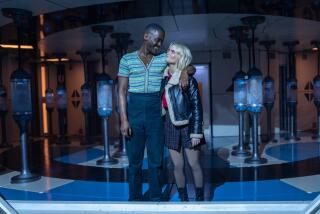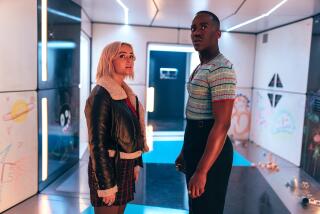Never fear, ‘Doctor Who’ is here (again)
- Share via
That necessity is the mother of invention is nowhere more evident than in science fiction, where invention regularly breaks the bounds of what’s possible in order to accomplish what’s necessary. (If we reverse the polarity on the atomic thruster terminals, Captain, maybe we can get this microwave oven started again.) In the case of the long-running sci-fi adventure series ” Doctor Who,” a cult hit here and a national phenomenon at home in the U.K., the practical matter of replacing the lead actor inspired what has become the hallmark of the series, and of the character: The Doctor dies, then regenerates: the same man but different; a different man, but the same.
Beginning Saturday on BBC America, the new season — the 31st since the show began, and the fifth (not counting 2009’s “year of specials”) since writer Russell T Davies was hired to bring it back to life after a 16-year hiatus — features a new Doctor, Matt Smith. Steven Moffat, already the author of several much-admired “Doctor Who” episodes, is the new show runner and head writer. There are new producers, as well, and a new opening, a new logo, and (I am geeky enough to say “excitingly”) a new look for the TARDIS, the Doctor’s space-time machine.
It takes no time at all for the new team to establish its authority; the new “Who” feels at once traditional and fresh, and completely right. We begin where we left off, with the TARDIS out of control and careening toward Earth, having been damaged during the regeneration of 10th Doctor David Tennant into 11th Doctor Smith. It crash lands in the back yard of little Amelia Pond (an excellent Caitlin Blackwood), who has just prayed to Santa to send her someone to fix a scary crack in her wall.
“I’m the Doctor,” the Doctor says, taking charge. “Do everything I tell you, don’t ask stupid questions, and don’t wander off.” And then he walks into a tree.
Moffat’s first episode as head writer recalls bits and moods from his earlier work on the series — the Doctor’s several visits to a waiting Amy echo “The Girl in the Fireplace”; a ward full of coma patients under alien influence recalls “The Empty Child.” Here again, he likes his monsters disguised, or difficult to see (the deadly statues of “Blink,” the shadowy swarms of “Silence in the Library”). He even quotes himself, on the “wibbly-wobbly, timey-wimey” nature of Time. Indeed, the script for Saturday’s opener is enough of a piece with what’s gone before that I can imagine Tennant or Ninth Doctor Christopher Eccleston playing it with only slight adjustments.
And yet it’s also clearly a new day. Smith, who was 26 when filming began, is the youngest Doctor yet, and he plays the character as a sort of mad newborn with a long memory. Pairing him with an even younger sidekick, wide-eyed, feisty Amy Pond (Karen Gillan — who is Amelia at 21 — redoubles that energy and seems a purposeful contrast to the last Doctor’s increasingly haunted tenure. (It’s a kind of reverse twist on “Peter Pan,” in which it’s the grown-up girl and not the child she was who goes sailing off into the sky with an ageless sprite.) And yet Smith also seems suitably weighty — plausibly a 900-year-old time traveler from another planet, to the extent one can describe such a thing as “plausible,” or has any basis for the judgment.
“You are not of this world,” an alien observes.
“No,” replies the Doctor, who has repeatedly made it his business to save the world he is not of. “But I’ve put a lot of work into it.”
More to Read
The complete guide to home viewing
Get Screen Gab for everything about the TV shows and streaming movies everyone’s talking about.
You may occasionally receive promotional content from the Los Angeles Times.







